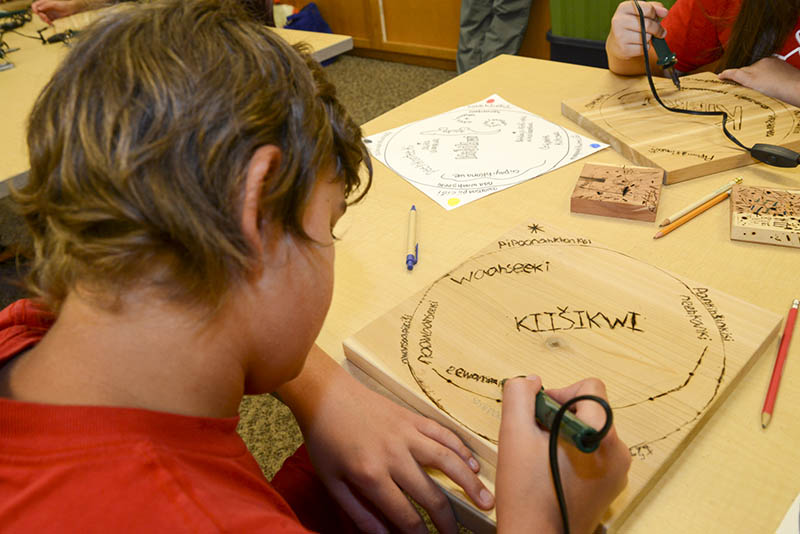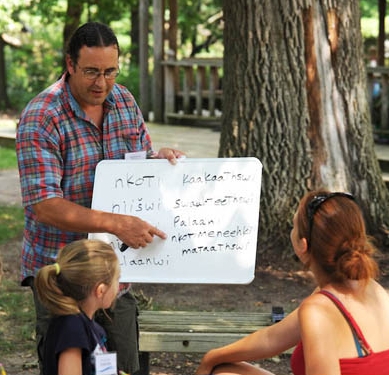
Physical health tied to native language use
Second of a three-part series about Miami University's ongoing partnership with the Miami Tribe of Oklahoma

Learning their native language: Participants in the Miami Tribe of Oklahoma Eewansaapita Summer Youth Educational Experience, Ft. Wayne, Indiana, 2015 (photos courtesy of Myaamia Center Archives).
By Claire Wagner, university news and communications
An academic review of research suggests a link between an indigenous community’s language vitality and its members’ health.
For more than two centuries, U.S. government programs such as mandatory boarding schools forced Native Americans to learn European culture and language and forego their own. The outcome of these concerted efforts was a cumulative decline in the use of native languages during the last decade and a growing sense of cultural shame among those who directly experienced these oppressive forces, said Daryl Baldwin, director of the Myaamia Center at Miami University. Baldwin is co-author of an article summarizing an emerging field of research regarding indigenous people’s health in relation to language and cultural maintenance.
Language transmission is a particularly effective means of reinforcing culture and identity within a community, say the article authors in “Healing through language: Positive physical health effects of indigenous language use” (F1000 Research 2016). Language is also an efficient means of reinforcing membership or inclusion in a community.
“For many of us who have been working in the field of language revitalization in our communities over the last couple of decades, we are witnessing increased positive communal interactions and an improved sense of well-being among the youth who are coming through our community programs and choosing to go on to college,” noted Baldwin.
Various studies have shown that forced relocation, assimilation and language termination create schisms in one’s identity or sense of self. Such schisms can cause indignity, hopelessness and depression, leading to poor health among some Native Americans, a result researchers call historical trauma.
Forced displacement of native peoples and the decline in their languages “caused the loss of social and behavioral knowledge and understanding that was created over millennia, ultimately contributing to disastrous, endemic health deficits.”1

National Breath of Life Institute 2015 workshop: Oneida Language team at the Smithsonian National Anthropological Archives.
The authors found several studies from 2004-2014 that showed a variety of positive results of indigenous language use:- For indigenous groups in British Columbia, Canada, in which 50 percent of the community is conversationally fluent, the youth suicide rate was one-sixth that of less fluent indigenous bands. The language factor was consistent even when other cultural factors were subtracted from the analysis.
- The percentage of smokers in U.S. Southwestern tribes, where indigenous languages are widely spoken, was 14 percent, compared to 50 percent among Northern Plains tribes, where language use is sparse.
- Canadian First Nations groups with greater cultural retention as indexed by language use had significantly lower rates of diabetes after factoring out socio-economic factors.
- In Australia, those who spoke their heritage language of Aboriginal and/or Torres Strait Islander were found to have half the rate of “poor health” as those who had switched to English.
Numerous programs and initiatives are underway to help communities revitalize their native languages, among them, the Smithsonian Institution’s Recovering Voices program, with which the Myaamia Center collaborates in supporting the National Breath of Life Institute.
The success of research and development efforts supporting language revitalization at the Myaamia Center at Miami University includes a four-year graduation rate for tribal students of 58 percent versus the average rate for Native American students of 22.5 percent.
“We are seeing the evidence that shows the degree to which individuals are connected with who they are has a ripple effect on their well-being,” said Susan Mosley-Howard, professor emerita of educational psychology at Miami, who is leading a longitudinal study of Myaamia student success rates.

Learning the Myaamia language with Daryl Baldwin.
Speaking an indigenous language is not solely responsible for improved health status. Community validation of the indigenous knowledge system, a strong communal economy, community-driven tribal education, self-governance, intergenerational mentorship, and youth empowerment through positive language-and-culture learning experiences all play significant roles in the ability of a minority language to thrive and for the community to experience healthy outcomes from the collective effort, the authors stress.
In May, Canadian Prime Minister Justin Trudeau acknowledged the language-health connection when he said restoring indigenous languages is key to preventing youth suicides in First Nation communities. “As an indicator of pride and identity, belonging and culture, indigenous languages are essential,” Trudeau said.
Healing Through Language, a program of the Endangered Language Fund, is another program that facilitates the support and assessment of language programs throughout Native America. Baldwin is on Healing Through Language’s advisory board.
The authors call for increased support for community-driven language and cultural revitalization in order to improve health in addition to the cultural and educational benefits.
“When tribes lead their own revitalization efforts, they more significantly reflect the needs and wants of the community. Even a small amount of language learning can have positive impacts on a community,” concluded Baldwin.
Read the first part of this series here: Knowing their tribal identity helps Native American students succeed.
![]()
1 Gracey M, King M: Indigenous health part 1: determinants and disease patterns. Lancet. 2009; Hallett D, Chandler MJ, Lalonde CE: Aboriginal language knowledge and youth suicide. Cognitive Development. 2007; King M, Smith A, Gracey M: Indigenous health part 2: the underlying causes of the health gap. Lancet. 2009.
